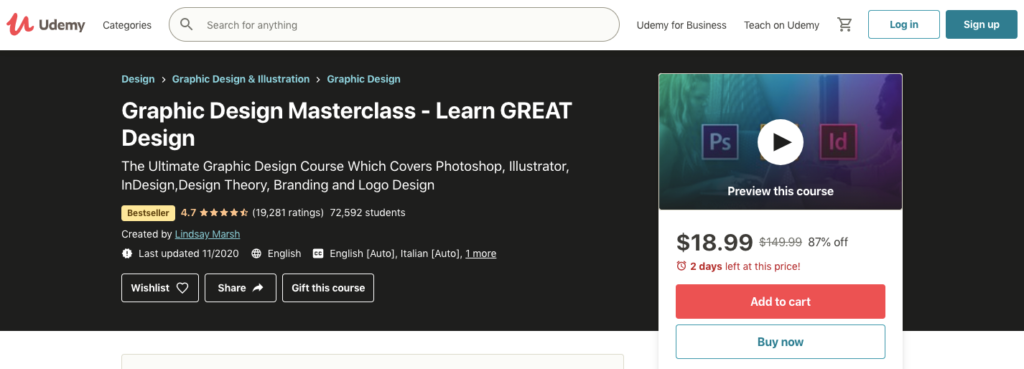If you’re thinking about teaching an online course, Udemy has probably popped up as one of the options. It’s an affordable — think free — course platform, but there are some solid Udemy alternatives you should learn about before you make your final decision.
Udemy is a go-to place for course creators because it’s free for instructors, and your course is put on Udemy’s browsable course marketplace.
If the marketplace model is what you’re interested in, there are a couple of free alternatives to Udemy on this list that have marketplaces. However, I’ve also included some Udemy alternatives that give instructors more options and freedom with how they create and market their courses.
Before I break down each option, let’s take a quick look at how Udemy compares to its alternatives.
| Cost | Marketplace | Instructor compensation | Best for | |
| Udemy | Free | Yes | 25%-97% of course cost based on how students sign up for the course | New course creators, those without a built-in audience |
| Skillshare | Free | Yes | Royalties based on the number of minutes a student spends watching the class, and $10 for every membership purchased through an instructor’s link | Creative courses that focus on personal or artistic development |
| PluralSight | Free | Yes | Royalties vary, but based on number of minutes your courses are watched | Tech-based courses |
| Teachable | $29-$249 /month | Yes, but in beta mode | Keep 100% of course cost, or 70% if course is sold through marketplace | Entrepreneurs, bloggers, online personalities |
| Thinkific | $0-$399 /month | No | Keep 100% of course cost, or 95% if on free plan | Entrepreneurs, bloggers, online personalities |
| iSpring Market | $77-$277 /month | No | Keep 100% of course cost | Entrepreneurs, bloggers, online personalities |
About Udemy
Udemy has been in the business of online learning for 10 years now, and they claim to have the world’s largest selection of online courses — 130,000 courses and growing. Udemy courses range in topics from professional development skills, IT master skills, to artistic courses that help students develop their creativity.

There are two strong features about Udemy. One, it’s free for instructors, and the marketplace is free marketing and course promotion. The downside of those things is that instructors have to split the revenue with Udemy, and courses are notoriously inexpensive.
There’s still an opportunity to earn good money with that model, and one of my readers now earns more than $80,000/month selling graphic design courses on Udemy and Skillshare. Below is one of her courses– more than 72,000 students!

Now that you’ve gotten some background on Udemy and took a quick look at it’s competitors, let’s dive into the top Udemy alternatives for 2021.
5 of the Best Udemy Alternatives for 2021
1. Skillshare
Skillshare is an online course marketplace that’s very similar to Udemy, except Skillshare courses are project-based. That means your course needs to have end goals in mind, like teaching a student how to design a logo, paint a winter watercolor bouquet, or creating your design system wishlist.
The majority of classes on Skillshare have a creative focus, and the most popular topics are design, illustration, writing, photography, productivity, and freelancing.

Pretty much anyone can create a course to sell on Skillshare — there are no applications or approval process. You are just asked to meet Skillshare’s course standards, which are:
- Focused and digestible: Courses average 20-60 minutes of video-based content, broken down into short 2-5 minute long videos.
- Project-based: Students should have a finished project after completing the course, and projects can be shared on the course page for prospective students to browse. Skillshare says it’s a way to receive peer and teacher feedback.
- Personal, honest, and human: Authenticity is key to Skillshare courses. They work to facilitate a welcoming and accepting space for students to learn.
Skillshare doesn’t have any tools on the platform for course instructors to use for designing their courses (like Udemy), but there is a helpful Teacher’s Handbook that offers tips for planning and producing classes. It also includes tips for how to engage students. and what kind of tools you need to teach.
Skillshare pricing
Skillshare is a 100% free alternative to Udemy. Teachers do not pay to create courses on Skillshare. Teachers earn money on Skillshare through royalties — you’re paid based on how many minutes students watch your courses. Or, you can earn referral bonuses, which is $10 for every student that becomes a Skillshare member through your unique link.
Best for
This Udemy Alternative is best for teaching courses that focus on creative skills. Popular classes include watercolor workshops, cooking, animation studio, and self-care creativity.
There are also professional skills in UI/UX design, leadership, web development, marketing, and entrepreneurship.
Related: How to Sell Courses From Your Own Website — A Beginner’s Guide
2. PluralSight Skills
PluralSight Skills is a Udemy alternative that focuses on teaching and building technology skills. What’s unique about this platform is that students can test skills and then be placed on a path to sharpening them.
For example, JavaScript Core Language is a popular path, and there are 10 courses taught by different instructors teaching everything from basics through generators, iterators, modules, security, and more.
PluralSight teachers are called authors, and new teachers must complete an application process to be accepted. It includes a 10 minute audition video about whatever topic you want to teach. The goal is to show PluralSight that you can successfully teach a concept and produce a video.
You are responsible for creating all of your own course material — videos, text lessons, designing projects, creating assessments, etc. Once you’ve finished the production process for a module, you send it to a PluralSight editor to review the content, and then you will need to make any recommended changes or edits. You do this for each module until your course is completely ready to be published.
PluralSight pricing
PluralSight is completely free for authors, but there is a more stringent application process than any of these other Udemy alternatives. PluralSight authors are paid royalties on their courses, and you sign a contract once your course is approved that includes your personal compensation breakdown.
Author compensation varies from author to author, but according to Indeed, the average PluralSight Author earns $80,850 annually.
Best for
PluralSight is definitely focused on tech-focused courses taught by professionals in their field.
Become a PluralSight Skills instructor
3. Teachable
Teachable is a major player in the e-learning world, and it’s what we’ve used for our Facebook Side Hustle course based on recommendations from some of my blogger friends.
Teachable is a Udemy alternative that is more similar to the iSpring Market and Thinkific. For course creation, Teachable has a bulk importer and accepts audio, text, video, PDF, and HTML files. There’s a drag-and-drop editor to place each lesson in the correct module. Your Teachable course can include self-paced, drip, or live classes through third-party sites like Livestream.
All Teachable courses come with unlimited video, courses, and hosting. You also get integrated payment processing, Zapier integrations, student management, lecture comments, basic quizzes, no fees on free courses, and VAT for the EU.
Teachable recently launched Discover, a course marketplace that’s similar to Udemy’s. Teachable said it has a “curated collection of some of the best courses on Teachable.”
Discover is currently in beta mode, so they are not adding new courses to the marketplace. We’ll be updating when Discover is more widely available.
Teachable pricing
Teachable used to have a free plan — it was fairly limited — and there are now three options:
- Basic $29/month: Unlimited students, 5% transaction fees, members-only community, instant payouts, product support, course creator training, coupon codes, drip course content, and integrated email marketing.
- Pro $99/month: Everything in Basic plus no transaction fees, 5 admin-level users, graded quizzes, advanced reports, unbranded website, course completion certificates, course compliance, and integrated affiliate marketing.
- Business $249/month: Everything in Pro plus 20 admin-level users, priory product support, manual student imports, bulk student imports, custom user roles, advanced theme customization, group coaching calls,
For courses that make it to Discover, Teachable’s Udemy alternative marketplace, Teachable will collect a 30% revenue share because the marketplace is promotional.
Best for
Teachable is best for entrepreneurs, freelancers ready to build their brand, and bloggers. Teachable does not have a built-in marketplace like Udemy or Skillshare, you’ll need to market your course.
4. Thinkific
mal_link merchant=”thinkific” child=”udemyalt” text=”Thinkific” /] is another powerful course builder that’s more similar to iSpring than Udemy, meaning it’s a robust platform with tools to create multimedia rich courses. Also unlike Udemy, Thinkific is not a course marketplace — you get the tools to market and sell courses how you want.

Thinkific instructors create a school, which is the website where all of your courses are hosted. You can add additional pages for an About Me section, FAQs, or anything else that’s relevant to your students.
Instructors can create courses with videos, PDFs, voice-over Powerpoint presentations, downloadable content, student discussions, quizzes, surveys, and text. You can even create private and hidden courses, prerequisite lessons, and have multiple teachers.
There are options for promotional offers to better market your course, like coupons and bundles. You can even create an affiliate program for your course using Thinkific.
There isn’t an application or approval process for Thinkific courses, and you don’t need any background in coding or design to create an intuitive online learning experience on Thinkific. There’s a drag-and-drop editor, premade templates and themes, and plenty of Zapier integrations to fit your unique course needs.
While Thinkific is similar to Udemy alternative iSpring, Thinkifc does not support SCORM content. You’ll also have to use a third-party video host like Vimeo, Wistia, or YouTube because there are limited video hosting capabilities.
One of the things that many online instructors like about Thinkific is the bulk uploader. You can create all of your content in advance, upload it at that same time, and then drop it into place in your course.
Your Thinkific course is sold through your personal payment gateway, which integrates with PayPal or Stripe.
Thinkific pricing
Thinkific has a four-tiered pricing system, including a free Udemy alternative. It is limited compared to other paid plans, but it still has more features than Udemy, including: full e-commerce suite, upsell offer, coure discussion forums, multiple instructor profiles, and instant access to your funds.
The paid Thinkific plans are:
- Basic $39/month: Everything in Free, plus unlimited courses and students, coupons, drip content, email students, custom domain, email integrations, Zapier triggers, affiliate reporting, manual student enrollment and exports.
- Pro $79/month: Everything in Basic, plus 2 site admin accounts, 5 course admins/authors, private and hidden courses, advanced course pricing options, memberships and bundles, certificates, priority support, live Zoom lessons, and assignments.
- Premier $399: Everything in Pro, plus 5 site admins, 15 group analysts, 50 course admins/author, single sign on, onboarding package, and access to Thinkific’s Unlimited Growth Package.
Best for
Thinkific is best for entrepreneurs who are ready to add online course content to their offerings. Compared to the other paid Udemy alternatives, Thinkific is one of the more affordable options, although it lacks some of the high-level features for creating truly interactive courses.
Related: Kajabi Review 2021 (Newest Features) — Will it Help You Sell Courses?
5. iSpring Market
Unlike the first Udemy alternatives on this list, iSpring Market is a fully functional LMS (learning management system) that has tools for building, marketing, and selling courses online. These additional features mean you are in complete control over how your courses are organized and marketed to students.
iSpring’s course builder supports nearly every kind of content type — audio, text, video, SCORM, HTML, and PDFs. You organize courses into chapters with features that allow you to build immersive online courses, including quizzes, simulations, and more.
This Udemy alternative also gives you access to student analytics. In your iSpring Market dashboard, you can see how individual students are progressing through your courses. This presents opportunities for re-engagement if you notice a student is stuck on a particular lesson.
The marketing tools on iSpring let you set up a user friendly storefront to host all of your classes, and you can add your personal business branding. iSpring also has high-converting mal_link merchant=”clickfunnelslistbuilding” child=”udemyalt” text=”sales funnels” /], you can create coupons and discounts, upsells, and freebies.
Because iSpring Market courses are sold through a business marketplace you create on the site, you can set up payments through a variety of gateways. That includes Payal, Stripe, or Authorize.net.
iSpring pricing
The cost of iSpring Market is based on the number of registered users who are taking your courses and the amount of content in your marketplace:
- 500 users and 25 GB: $77/month or $924/year
- 1000 users and 50 GB: $147/month or $1,764/year
- 2000 users and 100 GB: $277/month or $3,324
You keep 100% of sales from your courses, and you’re in complete control of how much you charge for your courses.
Best for
iSpring Market is a Udemy alternative that can be a good fit for lots of different course creators, especially individual business owners, like bloggers or freelancers. Because you have total control over how you structure your course content, you can really create a unique experience for your students.
Create a course on iSpring Market
The final word on Udemy alternatives
I think a lot of first time course creators will be satisfied with Udemy or Skillshare– they are free, low pressure ways to start selling courses. Where those free platforms fall short is with limited teaching and marketing tools.
And because you’re on a wide marketplace, there’s pressure to price your courses on the lower end. No one wants to have the most expensive house on the block.
On the flipside, the more expensive and flexible course platforms, like Teachable and Thinkific, give you lots of tools to create and market your courses, but it’s more difficult to sell them if you don’t have a built-in audience.
The reality is, you can make money with any of these course platforms. Spend some time looking at all of the features, read reviews, and pick something that feels like the best option for your audience.




Leave a Reply